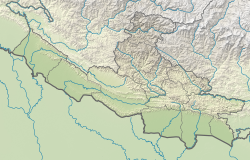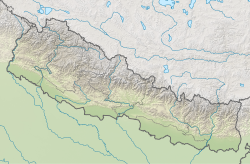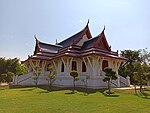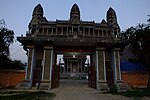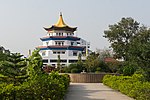Lumbini
लुम्बिनी | |
|---|---|
 Maya Devi Temple, Lumbini marking the Buddha's birthplace | |
| Coordinates: 27°28′53″N 83°16′33″E / 27.48139°N 83.27583°E | |
| Country | Nepal |
| Province | Lumbini Province |
| District | Rupandehi |
| Municipality | Lumbini Sanskritik |
| Government | |
| • Type | Development trust |
| • Body | Lumbini Development Trust |
| Elevation | 150 m (490 ft) |
| Time zone | UTC+05:45 (NST) |
| Postal Code | 32914 |
| Website | www |
| UNESCO World Heritage Site | |
|---|---|
| Location | Rupandehi District, Nepal |
| Criteria | Cultural: iii, vi |
| Reference | 666 |
| Inscription | 1997 (21st Session) |
| Area | 198.95 ha |
| Buffer zone | 22.78 ha |
| Coordinates | 27°28′53″N 83°16′33″E / 27.48139°N 83.27583°E |


| Pilgrimage to |
| Buddha's Holy Sites |
|---|
 |

Lumbinī (Nepali: लुम्बिनी pronounced [ˈlumbini] , "the lovely") is a Buddhist pilgrimage site in the Rupandehi District of Lumbini Province in Nepal. It is the place where, according to Buddhist tradition, queen Maya gave birth to Siddhartha Gautama at around 623 BCE.[2][3] Gautama, who, according to Buddhist tradition, achieved Enlightenment some time around 528 BCE,[4][5] became Shakyamuni Buddha and founded Buddhism.[6][7][8] Lumbini is one of many magnets for pilgrimage that sprang up in places pivotal to the life of the Buddha.
Lumbini has a number of old temples, including the Mayadevi Temple, and several new temples, funded by Buddhist organisations from various countries. Most of the temples have already been completed and some are still under construction. Many monuments, monasteries and a museum, and the Lumbini International Research Institute are also within the holy site. Also, there is the Puskarini, or Holy Pond, where Mayadevi, the Buddha's mother, is believed to have taken the ritual dip prior to his birth and where he also had his first bath. At other sites near Lumbini, earlier Buddhas were, according to tradition, born, then achieved ultimate Enlightenment and finally relinquished their earthly forms.[9]
Lumbini was made a World Heritage Site by UNESCO in 1997.[2][3][note 1]
In Buddha's time
[edit]In the time of the Buddha, Lumbini was situated east of Kapilavastu and south-west of Devadaha of Shakya, an oligarchic republic.[11][12] According to the Buddhist tradition, it was there that the Buddha was born.[13] Ashoka Pillar of Lumbini, a monolithic column with an inscription in the ancient Brahmi script discovered at Rupandehi in 1896, is believed to mark the spot of Ashoka's visit to Lumbini. The site was not known as Lumbini before the pillar was discovered.[14] The translation of inscription (by Paranavitana) reads:
"When King Devanampriya Priyadarsin had been anointed twenty years, he came himself and worshipped (this spot) because the Buddha Shakyamuni was born here. (He) both caused to be made a stone bearing a horse and caused a stone pillar to be set up, (in order to show) that the Blessed One was born here. (He) made the village of Lumbini free of taxes, and paying (only) an eighth share (of the produce)."[15][16][note 2]
The park was previously known as Rupandehi, 2 mi (3.2 km) north of Bhagavanpura. The Sutta Nipáta (vs. 683) states that the Buddha was born in a village of the Sákyans in the Lumbineyya Janapada. The Buddha stayed in Lumbinívana during his visit to Devadaha and there preached the Devadaha Sutta.[19]
Pillar of Ashoka
[edit]In 1896, former Commander-In-Chief of the Nepalese Army General Khadga Shamsher Jang Bahadur Rana and Alois Anton Führer discovered a great stone pillar at Rupandehi, according to the crucial historical records made by the ancient Chinese monk-pilgrim Xuanzang in the 7th century CE and by another ancient Chinese monk-pilgrim Faxian in the early 5th century CE. The Brahmi inscription on the pillar gives evidence that Ashoka, emperor of the Maurya Empire, visited the place in 3rd-century BCE and identified it as the birth-place of the Buddha.
At the top of the pillar, there is a second inscription by king Ripumalla (1234 Saka Era, 13-14th century CE), who is also known from an inscription at the Nigali Sagar pillar:
"Om mani padme hum May Prince Ripu Malla be long victorious 1234"
A second pillar of Ashoka is located about 22 kilometers to the northwest of Lumbini, the Nigali Sagar pillar (with inscription), and a third one 24 kilometers to the west, the Gotihawa pillar (without inscription).
Lumbini complex
[edit]
Lumbini is 4.8 km (3 mi) in length and 1.6 km (1.0 mi) in width. The holy site of Lumbini is bordered by a large monastic zone in which only monasteries can be built, no shops, hotels or restaurants. It is separated into an eastern and western monastic zone, the eastern having the Theravadin monasteries, the western having Mahayana and Vajrayana monasteries. There is a long water filled canal separating the western and eastern zones, with a series of brick arch bridges joining the two sides along the length. The canal is serviced by simple outboard motor boats at the north end which provides tours.The holy site of Lumbini has ruins of ancient monasteries, a sacred Bodhi tree, an ancient bathing pond, the Ashokan pillar and the Mayadevi Temple, a site traditionally considered to be the birthplace of the Buddha. From early morning to early evening, pilgrims from various countries perform chanting and meditation at the site.
-
Ancient ruins at Lumbini
-
Mayadevi Temple and ruins of ancient monasteries
Lumbini complex is divided into three areas: the Sacred Garden, the Monastic Zone and the Cultural Center and New Lumbini Village. The Sacred Garden remains the epicenter of the Lumbini area and consists of the birthplace of Buddha and other monuments of archaeological and spiritual importance such as the Mayadevi Temple, the Ashoka Pillar, the Marker Stone, the Nativity Sculpture, Puskarini Sacred Pond and other structural ruins of Buddhist stupas and viharas. The Monastic Zone, spanning an area of 1 square mile is divided into two zones: the East Monastic Zone which represents Theravada school of Buddhism and the West Monastic Zone which represents Mahayana and Vajrayana school of Buddhism, with their respective monasteries on the either side of a long pedestrian walkway and canal. Marking the monastic spot as a sacred pilgrimage site, many countries have established Buddhist stupas and monasteries in the monastic zone with their unique historical, cultural and spiritual designs. The Cultural Center and New Lumbini Village comprises Lumbini Museum, Lumbini International Research Institute, World Peace Pagoda of Japan, Lumbini Crane Sanctuary and other administrative offices.[9] The Government of Bangladesh is currently constructing a major Buddhist Monastery in Lumbini.[20]
-
Indian Temple
-
Japanese Stupa
-
Royal Thailand Monastery
-
Chinese Monastery
-
German Monastery
-
French Monastery
-
Sri Lankan Temple
-
South Korean Temple
-
Cambodian Monastery
-
Austrian Monastery
-
Singapore Monastery
-
Canadian Temple
-
Vietnamese Temple
-
Urgen Dorjee Choling Centre
-
Golden Temple of Myanmar
-
Russian Monastery (under construction, April 2024)
Excavation at the Mayadevi Temple in 2013
[edit]New excavations in the Mayadevi temple in Lumbini in 2013 revealed a series of the most ancient Buddhist shrines in South Asia extending the history of the site to a much earlier date.[21] According to Robin Coningham, excavations beneath existing brick structures at the Mayadevi Temple at Lumbini provide evidence for an older timber structure beneath the walls of a brick Buddhist shrine built during the Ashokan era (3rd-century BCE). The layout of the Ashokan shrine closely follows that of the earlier timber structure, which suggests a continuity of worship at the site. The pre-Mauryan timber structure appears to be an ancient tree shrine. Radiocarbon dating of charcoal from the wooden postholes and optically stimulated luminescence dating of elements in the soil suggests human activity began at Lumbini around 1000 BCE.[22] The site, states Coningham, may be a Buddhist monument from 6th-century BCE. Other scholars state that the excavations revealed nothing that is Buddhist, and they only confirm that the site predates the Buddha.[23][24]
Religious significance
[edit]Before parinirvana at the age of eighty, Gautama Buddha gave a sermon to his disciples on the significance of Lumbini as a place of pilgrimage (Dīghanikāya, 16; Mahāparinibbāṇa Sutta):[25]
"There are, O monks, four places on earth which a believing householder's son or a believing householder's daughter should commemorate as long as they live. Which are those four? –here the Venerable One has been born –here the Venerable One has attained the unsurpassable complete enlightenment –here the Venerable One has turned the threefold-turning, twelve-spoked lawful wheel –here the Venerable One has gone to the realm of complete nirvāṇa."
Along with Lumbini which is the Buddha's place of birth; Bodh Gaya where he attained enlightenment, Sarnath where he gave his first sermon and Kushinagar where he attained parinirvana are four most significant pilgrimage sites in Buddhism. These four places form a pilgrimage circuit along Buddha's Holy Sites.
Other developments
[edit]Nepal's central bank has introduced a 100-rupee Nepali note featuring Lumbini, the birthplace of Buddha. The Nepal Rastra Bank said the new note would be accessible only during the Dashain, Nepal's major festival in the time of September/October. It displays the portrait of Mayadevi, Gautam Buddha's mother in silver metallic on the front. The note also has a black dot which would help the blind recognise the note. The name of the central bank in Latin script would be printed on the note along with the date of printing in both the Christian Era and the Bikram Era. The new note is being issued following a cabinet decision 27 August.[26]

Nipponzan Myohoji decided to build a Peace Pagoda in the park in 2001, which is visited by many different cultures and religions every day. Because some Hindus regard the Buddha as an incarnation of Vishnu, thousands of Hindus have begun to come here on pilgrimage during the full moon of the Nepali month of Baisakh (April–May) to worship Queen Mayadevi as Rupa Devi, the mother goddess of Lumbini. Lumbini was granted World Heritage status by UNESCO in 1997.[2][3]
In 2011, Lumbini Development National Director Committee wad formed under the leadership of Prime Minister Prachanda.The committee was given the authority to "draft a master plan to develop Lumbini as a peaceful and tourism area and table the proposal" and the responsibility to gather international support for the same.[27]
In 2022 on Buddha's Birthday, Indian Prime Minister Narendra Modi and Nepalese Prime Minister Sher Bahadur Deuba, jointly laid the foundation stone for the Indian monastery in Lumbini.[28] Nepal-India cultural events are held annually in Lumbini highlighting the close spiritual and cultural connection between the two countries [29]
Tourism
[edit]In 2019, Lumbini received 1.5 million visitors across the world.[30]
Transport
[edit]Lumbini is a 10-hour drive from Kathmandu and a 30-minute drive from Bhairahawa. The closest airport is Gautam Buddha Airport at Bhairahawa, with flights to and from Kathmandu.[31]
Places to visit
[edit]New hotel construction
[edit]The nearest airport to Lumbini, Gautam Buddha Airport in Bhairahawa, is currently undergoing expansion. This small domestic airport is soon expected to become an international airport, with latest deadline set for 2019. The airport expansion attracted investors and hoteliers, and a series of new hotels are being constructed in and around Lumbini, hoping to cash in on the expected international tourist boom once the airport expansion work is completed.[33]
Sister cities
[edit]Lumbini has four official sister cities:
See also
[edit]- Bodh Gaya
- Sarnath
- Kushinagar
- Maya Devi Temple, Lumbini
- Lumbini Buddhist University
- Lumbini Development Trust
- Lumbini pillar inscription
- Pillars of Ashoka
- Ramagrama stupa
- Kindo Baha
- Pranidhipurna Mahavihar
- Rajgir
- World Peace Pagoda
- List of stupas in Nepal
- List of Buddhist monasteries in Nepal
Notes
[edit]- ^ Buddhist scriptures and travel accounts of Chinese monks, Faxian and Xuanzang, describe relative location of cities Lumbini, Sravasti, Kapilavastu and Rajgir. Based on these data, recent work [10] has used geometrical methods to pin-point the location of Lumbini. The results indicate that Kapilavastu and Lumbini were located to the south of Rajgir. Out of two historical Kosala's, South Koshala was located to the south of Rajgir. The results reject North Kosala as Gautama Buddha's native country.
- ^ Several alternative translations have been published.[17][18]
References
[edit]- ^ a b Le Huu Phuoc, Buddhist Architecture, p.269
- ^ a b c Centre, UNESCO World Heritage. "World Heritage Committee Inscribes 46 New Sites on World Heritage List". UNESCO World Heritage Centre.
- ^ a b c "Lumbini, the Birthplace of the Lord Buddha". UNESCO. Retrieved 1 March 2011.
- ^ Cousins, LS (1996). "The Dating of the Historical Buddha: A Review Article". Journal of the Royal Asiatic Society. 6 (1): 57–63. doi:10.1017/s1356186300014760. JSTOR 25183119. S2CID 162929573. Archived from the original on 20 December 2010.
- ^ Schumann, Hans Wolfgang (2003). The Historical Buddha: The Times, Life, and Teachings of the Founder of Buddhism. Motilal Banarsidass Press. pp. 10–13. ISBN 8120818172.
- ^ "Lumbini, the Birthplace of the Lord Buddha – UNESCO World Heritage Centre". Whc.unesco.org. Retrieved 19 August 2013.
- ^ ""Gautama Buddha (B.C. 623-543)" by T.W. Rhys-Davids, The World's Great Events, B.C. 4004-A.D. 70 (1908) by Esther Singleton, pp. 124–35".
((cite journal)): Cite journal requires|journal=(help) - ^ "The Buddha (BC 623-BC 543) – Religion and spirituality Article – Buddha, Bc, 623". Booksie. 8 July 2012. Retrieved 19 August 2013.
- ^ a b "Lumbini Development Trust- Birthplace of Buddha, Historical Place of Nepal, The World Heritage SiteLumbini Development Trust". lumbinidevtrust.gov.np. Retrieved 28 January 2022.
- ^ Mishra, Ramakanta (December 2021). "Location of Kapilavastu: Resolving Contradictory Descriptions found in Buddhist Scriptures". Journal of the U.S. Sangha for Buddhist Studies. 02 (2): 64–76. ISSN 2692-7357.
- ^ "Ramagrama-Devadaha | Lumbini Development Trust". lumbini.planetwebnepal.com. Lumbini Development Trust. 2013. Retrieved 29 September 2016.
- ^ Violatti, Cristian (12 December 2013). "Kapilavastu". World History Encyclopedia. Archived from the original on 14 August 2016. Retrieved 29 September 2016.
- ^ J.i.52, 54; Kvu.97, 559; AA.i.10; MA.ii.924; BuA.227; Cv.li.10, etc.
- ^ Sen, Dr. A. C. (2008). Buddhist shrines in India. Kolkota: Maha Bodhi Book Agency. p. 24. ISBN 978-81-87032-78-6.
- ^ See Mukerji: Asoka, p. 27; see p. 201f for details
- ^ Paranavitana, S. (Apr. - Jun., 1962). Rupandehi Pillar Inscription of Asoka, Journal of the American Oriental Society, 82 (2), 163-167
- ^ Weise, Kai; et al. (2013), The Sacred Garden of Lumbini – Perceptions of Buddha's Birthplace (PDF), Paris: UNESCO, pp. 47–48, archived from the original (PDF) on 30 August 2014
- ^ Hultzsch, E. /1925). Inscriptions of Asoka. Oxford: Clarendon Press, pp. 164-165
- ^ MA.ii.810
- ^ "Bangladesh to construct Buddhist Monastery in Nepal's Lumbini". The Business Standard. 8 October 2021. Archived from the original on 14 November 2022. Retrieved 14 November 2022.
- ^ Centre, UNESCO World Heritage. "Earliest Buddhist shrines in South Asia discovered in Lumbini, Buddha's birthplace in Nepal". UNESCO World Heritage Centre. Retrieved 30 June 2023.
- ^ Coningham, RAE; Acharya, KP; Strickland, KM; Davis, CE; Manuel, MJ; Simpson, IA; Gilliland, K; Tremblay, J; Kinnaird, TC; Sanderson, DCW (2013). "The earliest Buddhist shrine: excavating the birthplace of the Buddha, Lumbini (Nepal)". Antiquity. 87 (338): 1104–23. doi:10.1017/s0003598x00049899. S2CID 54601247.
- ^ Richard Gombrich (2013), Pseudo-discoveries at Lumbini, Oxford Center for Buddhist Studies, Oxford University
- ^ Fogelin, Lars (2 March 2015). An Archaeological History of Indian Buddhism. Oxford University Press. ISBN 978-0-19-994822-2.
- ^ unesdoc.unesco.org https://unesdoc.unesco.org/ark:/48223/pf0000223986. Retrieved 9 April 2024.
((cite web)): Missing or empty|title=(help) - ^ "Buddha's birthplace in Nepal's 100-rupee note – Indistan News – National, Political and States News". Archived from the original on 2 December 2013.
- ^ "Lumbini Development Committee formed under Dahal's leadership". ekantipur. Archived from the original on 21 December 2011. Retrieved 17 October 2011.
- ^ "Lumbini Development Trust- Birthplace of Buddha, Historical Place of Nepal, The World Heritage SiteLumbini Development Trust". lumbinidevtrust.gov.np. Retrieved 3 April 2024.
- ^ Republica. "Nepal-India cultural festival held in Lumbini". My Republica. Retrieved 3 April 2024.
- ^ Sansar, Nepali (6 January 2020). "Lumbini Tourist Arrivals Reach 1.5 Million in 2019". Nepali Sansar. Retrieved 28 January 2022.
- ^ "Lumbini". Welcome Nepal. Archived from the original on 17 August 2013. Retrieved 19 August 2013.
- ^ "Things to do in Lumbini - birthplace of Buddha | Buddha Statues". www.buddha-statues.info.
- ^ "Airport construction triggers hotel boom in Rupandehi". Retrieved 11 July 2018.
- ^ "India-Nepal agree to establish sister-city relations between Lumbini and Kushinagar; check details of MoUs signed today".
- ^ "MoU on Twinning arrangements between Kathmandu-Varanasi, Janakpur-Ayodhya and Lumbini-Bodh Gaya as sister cities". mea.gov.in. Retrieved 8 March 2020.
- ^ "CÁCERES Y LUMBINI RUBRICAN SU HERMANAMIENTO EN UN 'DÍA HISTÓRICO'". 8 April 2021. Retrieved 8 April 2021.
- ^ "Lumbini Development Trust- Birthplace of Buddha, Historical Place of Nepal, The World Heritage SiteLumbini Development Trust". lumbinidevtrust.gov.np. Retrieved 1 July 2023.
Further reading
[edit]Bibliography
[edit]- Weise, Kai; et al. (2013), The Sacred Garden of Lumbini – Perceptions of Buddha's Birthplace (PDF), Paris: UNESCO, archived from the original (PDF) on 30 August 2014
External links
[edit]- Lumbini On Trial: The Untold Story
 Lumbini travel guide from Wikivoyage
Lumbini travel guide from Wikivoyage- Lumbini at the Open Directory Project
- Lumbini at WorldHeritageSite.org Listing
